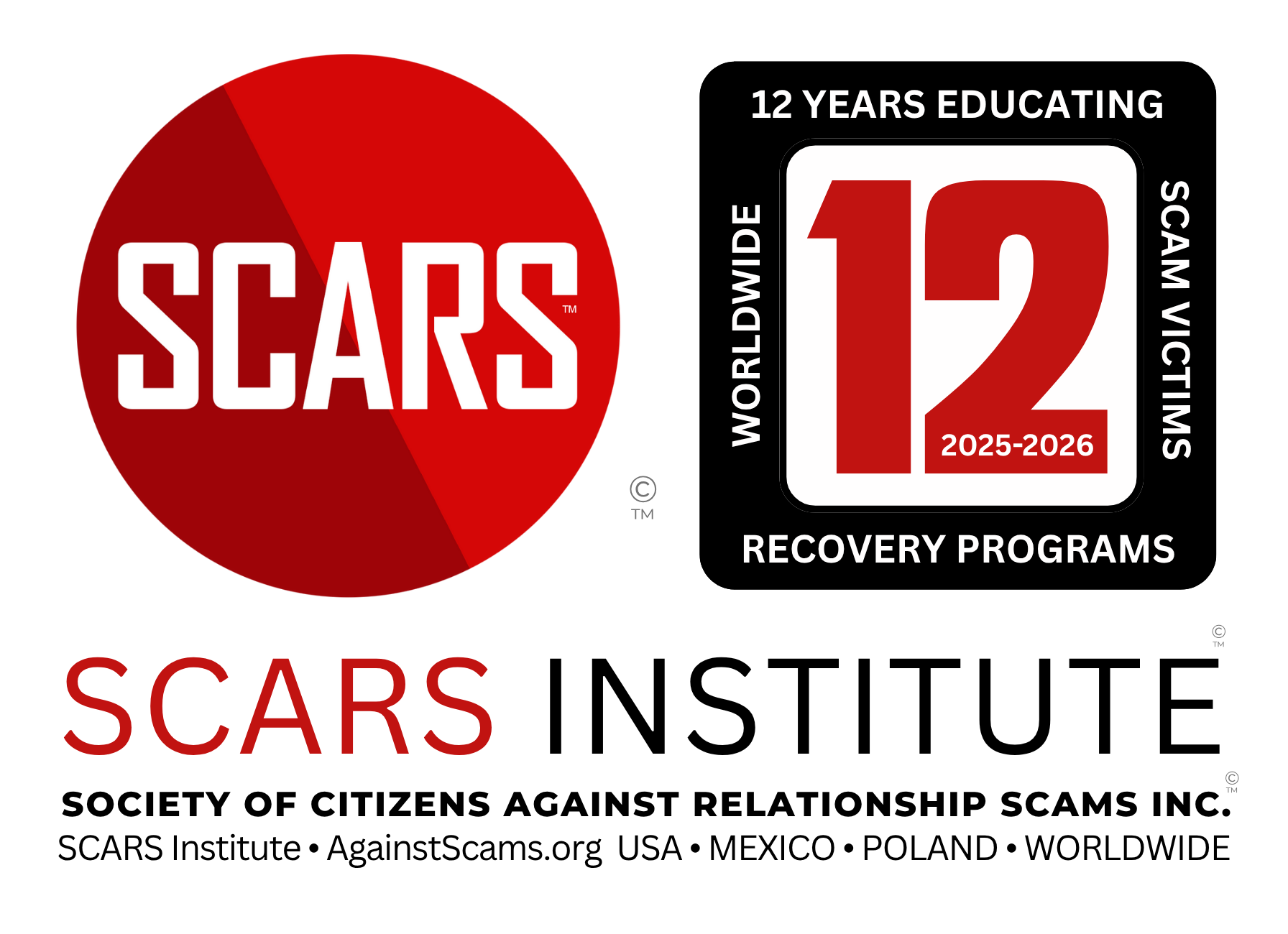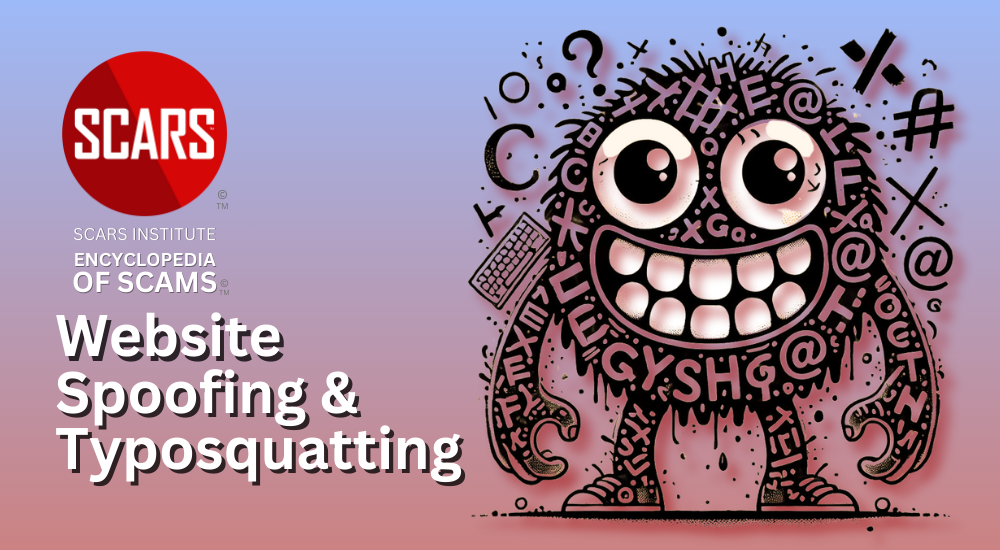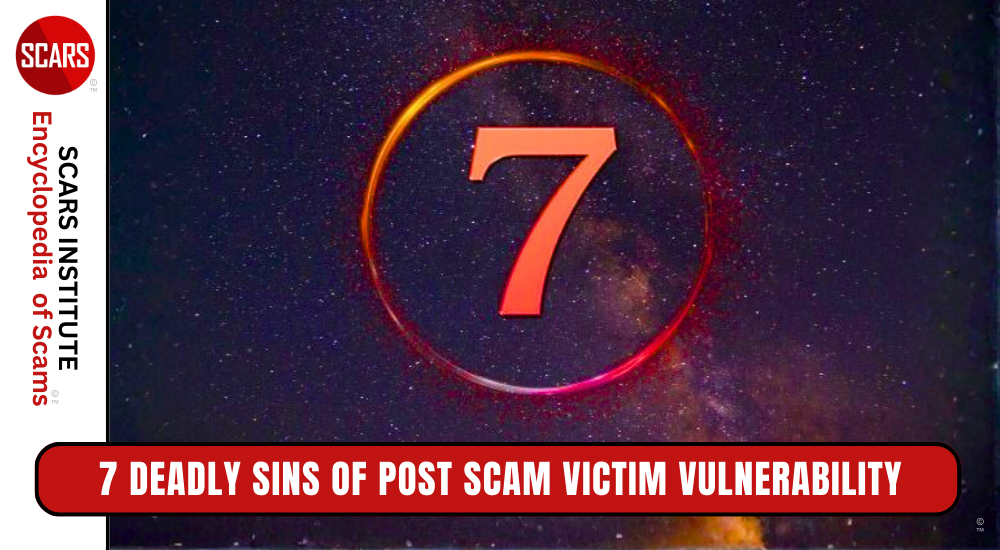
SCARS Institute’s Encyclopedia of Scams™ Published Continuously for 25 Years

Website Spoofing and Typosquatting – Social Engineering and Cybercrimes
Website Spoofing and Typosquatting: How Scammers Use Fake Domains to Trap Scam Victims through Social Engineering Techniques
How Scams Work – A SCARS Institute Guide
Author:
• Tim McGuinness, Ph.D., DFin, MCPO, MAnth – Anthropologist, Scientist, Director of the Society of Citizens Against Relationship Scams Inc.
Article Abstract
Website spoofing and typosquatting are common cybercriminal tactics used to deceive users into visiting fraudulent websites that look legitimate. Scammers utilize various strategies, such as misspelling domain names, homograph attacks (using look-alike characters from different alphabets), and subdomain spoofing to create convincing URLs.
Once victims are lured to these fake sites, cybercriminals can steal sensitive information, install malware, or commit financial fraud. By leveraging social engineering techniques, such as creating a sense of urgency or trust, scammers make their websites appear genuine, often using HTTPS to build credibility. To protect against these schemes, users should double-check URLs, avoid clicking suspicious links, and use security tools to detect malicious sites. The evolution of these tactics highlights the importance of vigilance and education in cybersecurity.

Website Spoofing and Typosquatting: How Scammers Use Fake Domains to Trap Scam Victims through Social Engineering Techniques
Website spoofing and typo domains (also known as typosquatting) are common techniques used by scammers, cybercriminals, and fraudsters to deceive internet users. By creating deceptive websites that appear legitimate, criminals aim to steal sensitive information, distribute malware, or lure victims into scams like pig butchering scams, phishing, or fraudulent investment schemes. Below, we’ll explore the most common methods scammers use to spoof domains and how they exploit them to trap unsuspecting victims.
Typosquatting: The Use of Misspelled Domain Names
Typosquatting involves registering domain names that are deliberately misspelled versions of legitimate, well-known websites. Scammers rely on the fact that users may accidentally type a web address incorrectly and end up on the fake site instead of the intended legitimate site.
Example techniques:
Omitting a letter: For example, typing “googel.com” instead of “google.com.”
Swapping adjacent letters: Common in typosquatting, this includes domains like “amzon.com” instead of “amazon.com.”
Adding extra characters: Domains that add extra letters like “faceebook.com” can trick users into believing it’s the real website.
Changing domain extensions: Switching “.com” to “.co” or “.net” is a common strategy. Scammers may use “paypal.co” to deceive someone intending to visit “paypal.com.”
These sites often look identical to the real ones, and scammers may install malicious software or steal login credentials, leading to identity theft or further fraud.
Homograph Attacks: Using Look-Alike Characters
A homograph attack involves using characters from different alphabets that look nearly identical to those in the legitimate domain name. Scammers take advantage of the fact that many characters in non-Latin scripts resemble Latin letters, and they replace letters in a legitimate URL with these characters.
Example:
Replacing the letter “o” in “google.com” with a Cyrillic “о” (which looks visually identical but is a different Unicode character).
Using accented letters like “paypaĺ.com” instead of “paypal.com.”
These fraudulent URLs can be hard to detect by simply glancing at the address bar, making them highly effective for phishing attacks.
Homograph attacks, also known as IDN (Internationalized Domain Name) homograph attacks, exploit visually similar characters from different writing systems or character sets to deceive users into thinking they are visiting legitimate websites. Below are 55 pairs of look-alike characters used in homograph attacks:
- a (Latin) and а (Cyrillic)
- o (Latin) and ο (Greek)
- i (Latin) and і (Cyrillic)
- e (Latin) and е (Cyrillic)
- c (Latin) and с (Cyrillic)
- p (Latin) and р (Cyrillic)
- x (Latin) and х (Cyrillic)
- s (Latin) and ѕ (Cyrillic)
- r (Latin) and г (Cyrillic)
- u (Latin) and υ (Greek)
- h (Latin) and һ (Cyrillic)
- w (Latin) and ѡ (Cyrillic)
- y (Latin) and у (Cyrillic)
- d (Latin) and ԁ (Cyrillic)
- n (Latin) and п (Cyrillic)
- b (Latin) and Ь (Cyrillic)
- v (Latin) and ν (Greek)
- m (Latin) and м (Cyrillic)
- l (Latin) and ӏ (Cyrillic)
- k (Latin) and κ (Greek)
- f (Latin) and ғ (Cyrillic)
- t (Latin) and τ (Greek)
- g (Latin) and ɡ (Cyrillic)
- z (Latin) and ʐ (Cyrillic)
- q (Latin) and զ (Armenian)
- A (Latin) and А (Cyrillic)
- B (Latin) and В (Cyrillic)
- C (Latin) and С (Cyrillic)
- E (Latin) and Е (Cyrillic)
- H (Latin) and Н (Cyrillic)
- I (Latin) and І (Cyrillic)
- J (Latin) and Ј (Cyrillic)
- K (Latin) and Κ (Greek)
- M (Latin) and М (Cyrillic)
- N (Latin) and Ν (Greek)
- O (Latin) and О (Cyrillic)
- P (Latin) and Р (Cyrillic)
- S (Latin) and Ѕ (Cyrillic)
- T (Latin) and Τ (Greek)
- V (Latin) and Ѵ (Cyrillic)
- W (Latin) and Ѡ (Cyrillic)
- X (Latin) and Χ (Greek)
- Y (Latin) and Ү (Cyrillic)
- Z (Latin) and Ζ (Greek)
- r (Latin) and г (Cyrillic)
- d (Latin) and ԁ (Cyrillic)
- q (Latin) and ԛ (Cyrillic)
- L (Latin) and ʟ (Cyrillic)
- F (Latin) and Ғ (Cyrillic)
- p (Latin) and ρ (Greek)
- a (Latin) and α (Greek)
- i (Latin) and ι (Greek)
- u (Latin) and ц (Cyrillic)
- n (Latin) and η (Greek)
- v (Latin) and ѵ (Cyrillic)
- L (Latin) and ӏ (Cyrillic) – the latter is a straight line like a lowercase “L.”
- G (Latin) and Ϭ (Coptic) – similar to the uppercase “G.”
- S (Latin) and Ƨ (Latin retroflex S) – an unusual character that can look like an “S.”
- d (Latin) and ԁ (Cyrillic) – they appear almost identical.
- a (Latin) and ɑ (Latin script) – a subtle difference, with “ɑ” being the Latin script for a turned “a.”
- t (Latin) and т (Cyrillic) – difficult to differentiate at a glance.
- r (Latin) and ṛ (Devanagari) – both appear similar in many fonts.
- u (Latin) and µ (Greek Mu) – common confusion, especially in technical URLs.
- p (Latin) and ⍴ (Mathematical symbol rho) – looks like a stylized version of “p.”
- k (Latin) and ĸ (Greenlandic) – a unique character that closely resembles the Latin “k.”
These character pairs are used to create URLs that appear legitimate at first glance, tricking users into believing they are visiting trusted websites when, in fact, they are accessing malicious ones.
Subdomain Spoofing and URL Masking
Subdomain spoofing is another tactic where fraudsters create a URL that looks like a legitimate domain by placing a subdomain that resembles a trusted brand in front of their malicious domain.
Example:
“paypal.com.fakesite.com”: This might trick a user into thinking it’s a legitimate PayPal website, while in reality, it’s hosted on “fakesite.com.”
Criminals exploit the fact that users may focus on the familiar brand name at the beginning of the URL, ignoring the real domain that follows. These sites often host phishing forms or malicious software.
Using HTTPS and SSL Certificates
While users are often taught to trust websites that display the HTTPS prefix and a padlock symbol in their browsers, scammers have caught onto this practice and now use legitimate SSL certificates on fake domains. The presence of HTTPS may give users a false sense of security, leading them to trust a spoofed website.
Scammers can easily obtain SSL certificates for malicious websites. As a result, many phishing sites now appear secure, tricking users into submitting personal and financial information on these sites.
URL Shorteners and Redirects
Scammers often use URL shorteners (like bit.ly or tinyurl.com) to mask the actual domain they’re sending victims to. These shortened URLs may be shared through emails, social media, or text messages. Once clicked, the user is redirected to a malicious or spoofed site.
How they work:
A URL like “bit.ly/abcdef” may look harmless, but when clicked, it redirects the user to a fake login page that mimics a trusted website like a bank or online store.
Scammers may use multiple redirects to mask the final destination, making it harder for users to detect malicious intent.
Cloned Websites and Fake Login Pages
Fraudsters often create exact clones of legitimate websites, copying design elements, logos, and even login forms. When a user unknowingly enters their credentials on these pages, the information is captured and sent to the attacker, who can then use it for further fraud, such as draining bank accounts or committing identity theft.
Example in scams like pig butchering:
In pig butchering scams, scammers might set up fake cryptocurrency investment platforms that look almost identical to legitimate ones. Victims are lured into thinking they’re investing in real assets, only to realize later that the site is fraudulent and their money is gone.
Exploiting Similar Domains for Email Scams
Scammers frequently create look-alike email addresses based on spoofed domains to launch phishing attacks. These emails often appear to come from trusted sources, such as banks, employers, or family members, urging recipients to click on links or download attachments.
Examples:
An email from “support@faceboook.com“ (with an extra “o”) may appear to be from Facebook’s support team but is actually a scammer attempting to steal credentials or deliver malware.
In some cases, scammers may use domain names with minor differences to impersonate a well-known business, leading to fraudulent invoices or financial requests being approved.
Combo-Squatting
In combo-squatting, scammers combine the legitimate brand name with additional keywords to create convincing but fraudulent domains. For instance, they might add words like “support,” “login,” or “secure” to make the URL appear more authentic.
Examples:
“paypal-support.com” could trick users into thinking they are visiting PayPal’s customer support page.
“amazon-login.com” might lead users to believe it’s a legitimate login page for their Amazon account, while it’s a phishing site.
Domain Hijacking and DNS Spoofing
Domain hijacking occurs when scammers gain unauthorized access to the domain registration and transfer the domain to their control. Once in control of the domain, they can create fraudulent pages or redirect users to malicious websites. DNS spoofing (also known as DNS poisoning) involves corrupting the Domain Name System so that users are directed to fraudulent websites without even knowing the domain has been compromised.
Social Engineering Techniques and Psychological Manipulation
Scammers don’t just rely on technical tricks but also employ social engineering and psychological manipulation to convince victims to visit spoofed domains. They may use urgency, fear, or promises of rewards (like investment returns or prizes) to trick users into visiting fake websites and submitting personal information.
How to Protect Yourself from Spoofed Domains
- Always double-check the URL before entering sensitive information. Pay attention to slight misspellings, misplaced characters, or unfamiliar extensions.
- Use browser extensions or tools that identify potentially dangerous websites.
- Avoid clicking on suspicious links in emails or messages, particularly those from unfamiliar senders.
- Enable two-factor authentication (2FA) wherever possible to add an extra layer of security.
- Report suspicious websites to your browser or cybersecurity firms. Visit reporting.AgainstScams.org to learn how to report.
Summary
Website spoofing and domain manipulation are evolving tactics that scammers use to exploit users’ trust and trick them into handing over personal information or money. As criminals become more sophisticated in their methods—leveraging typosquatting, homograph attacks, and social engineering—users must remain vigilant, informed, and cautious to avoid falling victim to these deceptive strategies. The rise in HTTPS adoption for fraudulent sites adds another layer of difficulty in identifying legitimate websites, making education and awareness key tools in the fight against cybercrime.
-/ 30 /-
What do you think about this?
Please share your thoughts in a comment below!
Table of Contents
- Website Spoofing and Typosquatting: How Scammers Use Fake Domains to Trap Scam Victims through Social Engineering Techniques
- Article Abstract
- Website Spoofing and Typosquatting: How Scammers Use Fake Domains to Trap Scam Victims through Social Engineering Techniques
- Typosquatting: The Use of Misspelled Domain Names
- Homograph Attacks: Using Look-Alike Characters
- Subdomain Spoofing and URL Masking
- Using HTTPS and SSL Certificates
- URL Shorteners and Redirects
- Cloned Websites and Fake Login Pages
- Exploiting Similar Domains for Email Scams
- Combo-Squatting
- Domain Hijacking and DNS Spoofing
- Social Engineering Techniques and Psychological Manipulation
- How to Protect Yourself from Spoofed Domains
- Summary
LEAVE A COMMENT?
Recent Comments
On Other Articles
- Arwyn Lautenschlager on Scam Victim Grooming – Turning On The Instant Emotions: “I can relate to the explanations of the various ways a scammer grooms/manipulate their victim. There were times when I…” Jan 6, 13:56
- on An Updated Compendium Of Confidence Tricks: “In my first scam, I received a $150,000 check address to my scammer from a company in California, but the…” Jan 4, 22:46
- on Romance Scammers – Top Lies They Tell – UPDATED 2024: “Thank you for the valuable information and telling us we just have to report it to the FTC, because the…” Jan 4, 19:12
- on Love Bombing And How Romance Scam Victims Are Forced To Feel: “I was loved bombed and sent flowers, he even asked me to find houses we could live in my town.…” Jan 4, 09:55
- on Scam Grooming: Finding Common Interests: “I was divorced and lost my mom in the same month, I had moved to my hometown and had very…” Jan 4, 09:18
- on Scammers Start By Grooming Scam Victims – Spotting An Online Scam Groomer – Grooming As A Scam Technique – 2024: “As I read this article, I could envision my former self (as if in a movie watching myself) in my…” Jan 3, 13:21
- on The Meaning Behind Scammer Gifts Sent To Romance Scam Victims – 2024: “They were probably purchased using stolen credit cards anyway.” Jan 3, 13:18
- on The Meaning Behind Scammer Gifts Sent To Romance Scam Victims – 2024: “I got flowers from my criminal, he had me take a picture with the flowers. He later gave me several…” Jan 3, 11:23
- on 7 Deadly Sins of Post Scam Victim Vulnerability – 2023 UPDATED 2026: “Thank you for a great article. I will continue to learn, through learning I can gain wisdom, use the steps…” Jan 3, 11:00
ARTICLE META
Important Information for New Scam Victims
- Please visit www.ScamVictimsSupport.org – a SCARS Website for New Scam Victims & Sextortion Victims
- Enroll in FREE SCARS Scam Survivor’s School now at www.SCARSeducation.org
- Please visit www.ScamPsychology.org – to more fully understand the psychological concepts involved in scams and scam victim recovery
If you are looking for local trauma counselors please visit counseling.AgainstScams.org or join SCARS for our counseling/therapy benefit: membership.AgainstScams.org
If you need to speak with someone now, you can dial 988 or find phone numbers for crisis hotlines all around the world here: www.opencounseling.com/suicide-hotlines
A Note About Labeling!
We often use the term ‘scam victim’ in our articles, but this is a convenience to help those searching for information in search engines like Google. It is just a convenience and has no deeper meaning. If you have come through such an experience, YOU are a Survivor! It was not your fault. You are not alone! Axios!
A Question of Trust
At the SCARS Institute, we invite you to do your own research on the topics we speak about and publish, Our team investigates the subject being discussed, especially when it comes to understanding the scam victims-survivors experience. You can do Google searches but in many cases, you will have to wade through scientific papers and studies. However, remember that biases and perspectives matter and influence the outcome. Regardless, we encourage you to explore these topics as thoroughly as you can for your own awareness.
Statement About Victim Blaming
Some of our articles discuss various aspects of victims. This is both about better understanding victims (the science of victimology) and their behaviors and psychology. This helps us to educate victims/survivors about why these crimes happened and to not blame themselves, better develop recovery programs, and to help victims avoid scams in the future. At times this may sound like blaming the victim, but it does not blame scam victims, we are simply explaining the hows and whys of the experience victims have.
These articles, about the Psychology of Scams or Victim Psychology – meaning that all humans have psychological or cognitive characteristics in common that can either be exploited or work against us – help us all to understand the unique challenges victims face before, during, and after scams, fraud, or cybercrimes. These sometimes talk about some of the vulnerabilities the scammers exploit. Victims rarely have control of them or are even aware of them, until something like a scam happens and then they can learn how their mind works and how to overcome these mechanisms.
Articles like these help victims and others understand these processes and how to help prevent them from being exploited again or to help them recover more easily by understanding their post-scam behaviors. Learn more about the Psychology of Scams at www.ScamPsychology.org
Psychology Disclaimer:
All articles about psychology and the human brain on this website are for information & education only
The information provided in this article is intended for educational and self-help purposes only and should not be construed as a substitute for professional therapy or counseling.
While any self-help techniques outlined herein may be beneficial for scam victims seeking to recover from their experience and move towards recovery, it is important to consult with a qualified mental health professional before initiating any course of action. Each individual’s experience and needs are unique, and what works for one person may not be suitable for another.
Additionally, any approach may not be appropriate for individuals with certain pre-existing mental health conditions or trauma histories. It is advisable to seek guidance from a licensed therapist or counselor who can provide personalized support, guidance, and treatment tailored to your specific needs.
If you are experiencing significant distress or emotional difficulties related to a scam or other traumatic event, please consult your doctor or mental health provider for appropriate care and support.
Also read our SCARS Institute Statement about Professional Care for Scam Victims – click here to go to our ScamsNOW.com website.
















Thank you for your comment. You may receive an email to follow up. We never share your data with marketers.